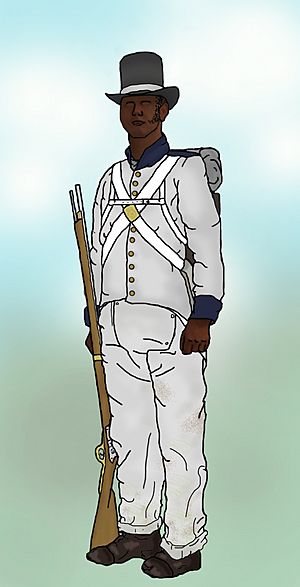Merikins facts for kids
The Merikins were a special group of Black Americans who became soldiers for the British during the War of 1812. These brave people were formerly enslaved in the United States. After fighting for the British in a group called the Corps of Colonial Marines, they were given a new home. In 1815–1816, they settled in the southern part of Trinidad.
In Trinidad, they lived among French-speaking Catholic communities. However, the Merikins kept their own culture, speaking English and practicing the Baptist faith. The name "Merikins" likely came from how some Americans pronounced "Americans" back then. Many of the villages and land grants given to them still exist in Trinidad today.
Contents
How the Merikins Started
During the American Revolution, the British had recruited formerly enslaved people to serve as Colonial Marines. The War of 1812 had a similar plan. This time, enslaved people who came into British hands were immediately considered free. There were no special conditions or deals for them to join.
Six groups, called companies, of these freedmen joined the Corps of Colonial Marines. They were recruited along the Atlantic coast, from Chesapeake Bay to Georgia. After the war, the British helped these Colonial Marines settle in different British colonies. These included Canada, Jamaica, and the Bahamas.
A British leader named Vice Admiral Sir Alexander Cochrane made an important announcement in 1814. He offered people leaving the United States a choice: they could join the British military or become free settlers. They could move to British lands in North America or the West Indies, where they would be welcomed.
After the war ended, the Colonial Marines were first sent to the Royal Naval Dockyard, Bermuda. Even though they had joined the military, they did not want to be moved to other regiments. Eventually, they agreed to settle in Trinidad.
The Governor of Trinidad, Sir Ralph Woodford, wanted more small farmers in his colony. So, he helped create a village for each company of Merikins. These villages were on the Naparima Plain in the south of the island. A local manager, Robert Mitchell, helped set up these settlements and get supplies for the new residents.
Life in the Company Villages
The Veteran Marines and their families arrived in Trinidad in 1816. There were 574 former soldiers, plus about 200 women and children. To help balance the number of men and women, more Black women were brought in later. These women had been freed from other places, like captured French slave ships.
Each of the six companies settled in its own village. A corporal or sergeant led each village, keeping a military-like order. Some villages were named after their companies, and the Fifth and Sixth Company villages still have those names today.
The villages were in a forested area of the Naparima Plain. This was near an old Spanish mission called La Misión de Savana Grande. Each Veteran Marine received 16 acres of land. Some of these plots are still farmed by their descendants today. The land was good for farming, but life was hard at first. They had to clear the land, and there were no roads, which was a big problem.
The settlers built their homes from the wood they cut down. They planted crops like bananas, cassava, maize, and potatoes. Rice was brought from America and was very useful because it could be stored for a long time.
Twenty years later, Governor Lord Harris helped improve the villages. He also arranged for the settlers to get official deeds for their land. This confirmed their ownership rights, as promised when they first arrived. As the Merikins became more successful, they played a big part in Trinidad's economy. They grew from just feeding themselves to growing crops like cocoa and sugar cane to sell. Later, oil was found on some of their lands. This allowed some descendants to lease their land for the oil rights. Others continued to work as independent market traders.
Merikin Religion and Beliefs
Many of the first Merikin settlers were Baptists. They came from strong religious groups common in places like Georgia and Virginia. The settlers kept this faith. Baptist missionaries from London helped them build churches in the 1840s.
The villages had pastors and other religious elders who were respected leaders. They followed strict rules about living a good life, including abstinence and a strong belief in hard work. African traditions were also important. These included the gayap system, where people helped each other in the community. They also used herbal medicine and practiced Obeah, which was a form of African tribal science.
A famous elder in the 20th century was "Papa Neezer," whose real name was Samuel Ebenezer Elliot (1901–1969). He was a descendant of an original settler, George Elliot. Papa Neezer was known for his ability to heal people and remove evil spirits. His religion mixed different beliefs. It included honoring Shango, making predictions from the "Obee seed," and finding wisdom in the Psalms. The Spiritual Baptist faith in Trinidad is a lasting part of the Merikin community's heritage.
Famous Merikins
The following people are descendants of this community:
- Tina Dunkley, American museum director
- Hazel Manning, Trinidadian senator and education minister
- Althea McNish, British textile designer
- Brent Sancho, footballer, Minister for Sport for Trinidad and Tobago
- Lincoln Crawford OBE, barrister, Chair, Independent Adoption Service
See also
- Black Refugee (War of 1812) – similar communities established in the Canadian provinces of Nova Scotia and New Brunswick.


